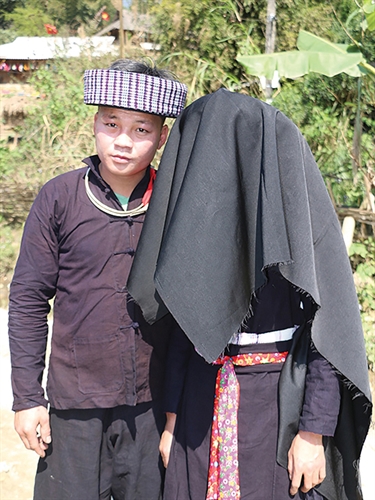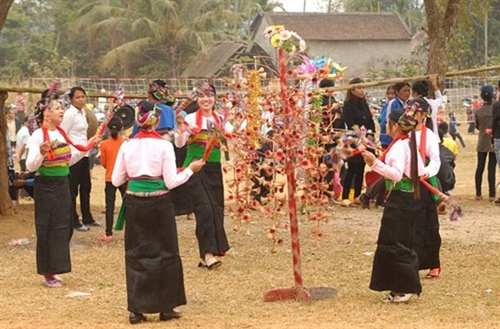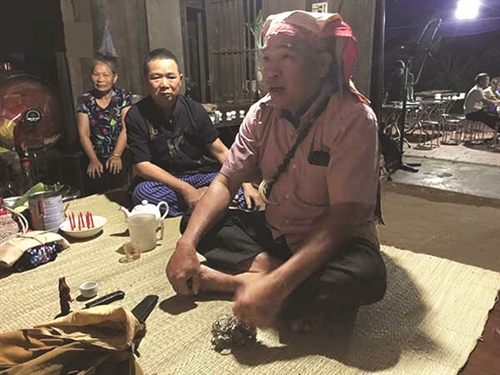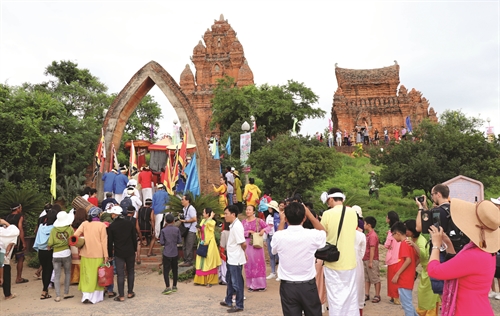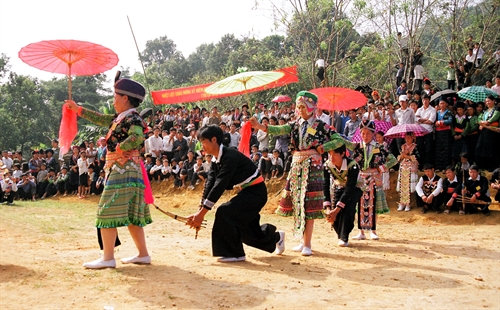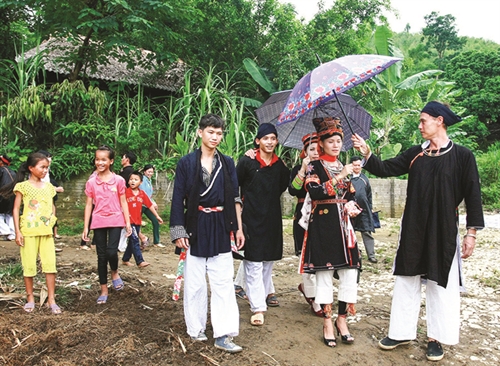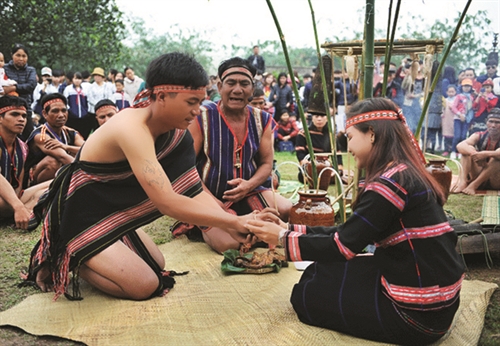Ta Thi Tam and Hoang Le Thao
Institute of Anthropology
Vietnam Academy of Social Sciences
A thread tying ritual, called hang van or et van, is an age-old practice of the Thai in the northwestern mountainous region of Vietnam and western parts of Nghe An, Ha Tinh and Thanh Hoa provinces, who believe a sick person can get well again after praying the deities of muong troi, the heaven, and having his wandering souls returned to the body through tying a thread around his wrist.
The ritual is officiated by a shaman for several times during the life of a Thai, especially newborns and the elderly. It is also an indispensible formality for weddings, funerals, elderly people’s birthday celebrations or death anniversaries. Depending on each occasion, Thai people use silver jewelry or threads of different colors for different purposes. Black threads are worn by people wishing for peace and health, red threads are worn by newlywed couples wishing for happiness, and white threads are worn by relatives of the deceased.
As the group believes that a man has seven souls, called van or khoan in Thai language, and a woman has nine ones, of which the main soul, called van co oc or khoan co oc, stays on the head top. When a person’s souls leave the body, he/she will get sick and even die. That’s why, when someone in a Thai family gets sick or has sleep problems, the family will invite a shaman to conduct a thread tying ritual to cure sickness and ward off bad luck. Before leaving for this ritual, the shaman plucks a small tree branch, throws it on the ground and tramples on it. In this ritual, the shaman offers the deities a box wrapped with a scarf containing a used shirt of the sick person, an object believed to contain the sick person’s souls, and a handful of salt and sticky rice. When the ritual is completed, the shaman takes the box to the holy forest and buries it there as the Thai believe that the forest deity will shield these souls from evil spirits and the sick will soon get well.
Thai families also hold thread tying rituals for their babies when they reach one month old. In this ritual, they offer sticky rice and chicken, wine and grilled fish to the deities of muong troi. After the ritual, the babies are given a silver necklace or bracelet or anklet which is expected to dispel evil spirits.
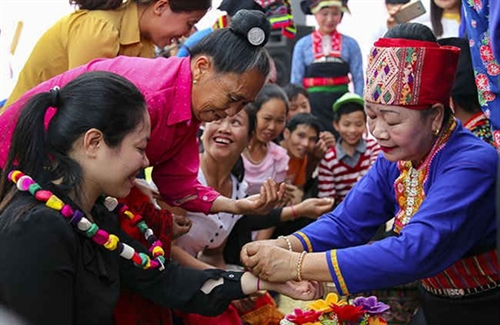 |
| Thread tying ceremony of Thai people__Photo: Internet |
For a wedding, two thread tying ceremonies will be held, one for the bride’s parents and another for the newlyweds. Before the groom’s party comes to take the bride home, the groom’s uncle officiates the bride’s ancestor worshipping rite in the altar compartment while the matchmaker conducts the thread tying ritual in the main compartment. In addition to a rattan tray of sticky rice, pork, betel leaves and areca nuts and wine offering to the deities, there must be a silver bracelet and used clothes of the bride’s parents. After completing all formalities, the shaman will tie a black thread around the wrist of each parent of the bride to pray for their well-being.
As soon as the new couple arrives at the groom’s home, another thread tying ceremony is organized in the bride’s compartment before the groom’s ancestor worshipping rite. The indispensible offerings to deities are the bride’s presents such as clothes and bracelets and, especially a red-colored dress which is prepared for the bride to wear in her parents-in-law’s funerals in the future. At the end of the ritual, red threads will be tied around the newlyweds’ wrists.
A thread tying ritual is also an important formality in longevity celebration which will be held only once in a lifetime when a Thai person reaches the age of 60. For this occasion, children and grandchildren will sacrifice buffaloes, cows, pigs and chicken and buy silver bracelets and necklaces and clothes as presents to their superiors.
The ritual begins with the formality of sending used shirts of the owner of the longevity celebration party and his wife to the home of his parents-in-law. In case the parents-in-law died, the shirts will be delivered to the wife’s next of kin, maybe her older brother, younger brother or another maternal relative, and left there for one month. Children and grandchildren also bring a rooster and a jar of rice wine as offerings to maternal ancestors and inform them of the presence of these souls in the family.
One day before the main ritual, the family sends their children, grandchildren, an unmarried couple and some old men to invite the main souls of the party owner, which are believed to stay in the shirt previously dispatched to the party owner’s parent-in-law, to return to his home. The parents-in-law will return the shirts to their daughter and son-in-law, together with some presents, including a nest of newly hatched broods, a pair of mats, two pottery buckets and other household utensils.
At the house of the party owner, his family places a copper tray on which they put betel leaves and areca nuts, a pair of silver bracelets, a roast rooster or a grilled fish, sticky rice, shirts of the party owner and his wife, and a piece of white cloth on a mat in the middle of the house’s playground and next to a jar of rice wine and a live pig. When everything is ready, the shaman who hosts the ritual will start reading prayers to invite the souls returning home.
After the delegation sent to pick up the souls arrives home, all presents given by the parents-in-law, excluding the nest of newly hatched broods, will be brought to the party owner’s compartment. Thai people believe that such gifts will bring a happy and prosperous life to the couple for the rest of their lives and help their souls find and reunite with each other in muong troi after they die. After the shaman finishes his prayers, children, grandchildren and relatives bow four times in front of the old couple. Finally, the shaman ties a thread around the wrists of the party owner and his wife and both hosts and guests enjoy the offerings and dance through the night.
Threat tying ritual is also held at funerals to protect the souls of the dead’s relatives and shamans who take part in the funerals from wandering spirits. For each funeral, right after the burial of the dead person, two threat tying ceremonies will be organized, one for the shaman and the other for the dead’s children and grandchildren.
The threat tying ritual for the major shaman will be conducted by another shaman in the family’s ancestor worshipping compartment. The offering tray includes two roosters, two bowls of rice, three pairs of chopsticks, a bowl of wine, a black thread, an arm length of cloth, a silver or aluminum bracelet, a betel leaf and four pieces of an areca nut. A gasoline lamp is lighted during the ritual to dispel bad evils. After praying, the ceremony host ties two black threads around the shaman’s wrist. The shaman will hang up all threads he is tied after funerals on the wall and never throw them away as the Thai believe that souls reside in these threads.
The family owner also prepares a tray of two roosters, two bowls of rice, wine, betel and areca nuts, a handful of chopsticks and black threads with the number equivalent to that of the participating children and grandchildren and another similar tray with two chopped roosters for the ritual held for his children and grandchildren.-

